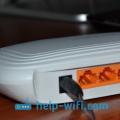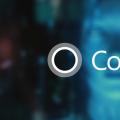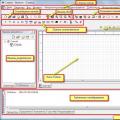After updating to a new version of iOS, you may notice that you do not like the firmware. In this case, there is an excellent solution - roll back the software to the optimal version, in your opinion. That is, if you updated to, for example, IOS 10, then you can easily install it on your iOS device 8 using the instructions below.
When is it necessary to rollback iOS?
Reasons to install an older version operating system The following circumstances may occur:
- With new firmware versions, the design changes, and not all users may like the new design.
- The most common reason is the appearance of freezes and glitches. Such problems happen for two reasons: either a new version of the firmware has become available to users in a too crude form, with errors in the code and shortcomings, or the device that was updated has become outdated for the loads created by new version IOS.
Please note that it is not possible to roll back any device to any version; you can view detailed information about which device to which firmware version can be rolled back to on the following website - http://appstudio.org/shsh. All data is located in table format.
How to roll back iOS to a specific version on an Apple device
Before you begin the process, you need to prepare the following things:
- iTunes installed on your computer and updated to the latest version.
- Your chosen version downloaded to an easily accessible folder software, having the IPSW format. You can download it from trusted websites that distribute IOS firmware for free, for example, using the following link - http://appstudio.org/ios. Download the firmware strictly for your device model, otherwise problems will arise during installation.
- A USB adapter that will connect your device to your computer.
If you have met all the above conditions, then the next step is to prepare the device itself for the rollback process.
Saving important data
Please note that when you roll back your device, all data, applications and media files from it are permanently erased, so it’s worth taking care of them. There is an option that allows you to delete files from the device, it will be discussed later in the article, but it is no less stable. You can save everything you need using a backup copy created as follows:
Disable password
Another important point is to disable the password and Touch ID, if it is supported and enabled on your device.

Deactivating Find My iPhone
Before any actions with the device’s firmware, you must disable the “Find iPhone” function, since, otherwise, iTunes simply will not allow you to perform any actions:

Firmware rollback
If all previous preparatory work has been carried out, then you can begin the rollback itself. It doesn't matter which device you're downgrading from, or from which version of iOS you're downgrading to.
- Connect the device to the computer using a USB adapter.
- Log in to the system.
- Go to your device's settings by clicking on the icon that looks like a phone or tablet.
- Hold down the Shift button on your keyboard if you're using Windows, or the Option button if you're using Mac OS. Without releasing the key, click on the “Restore” button.
- A window with folders will open; you need to specify the path to the firmware that you downloaded earlier.
- Wait while iTunes extracts the software from the firmware and installs it. The process can last from five minutes to half an hour, do not disconnect the device from the computer or interrupt the process with any actions, otherwise the device may enter endless recovery mode.
Rollback without data loss
This rollback option also exists; it allows you to rollback without losing the data on the device. To do this, in point 4 of the “Rolling Back Firmware” section, you need to click on the “Restore” button and the “Update” button. All other steps are completely the same. The only thing worth considering is that the execution full recovery, that is, resetting the system and installing it from scratch is safer, since the chance that any elements will remain from the previous version is much lower.
Video tutorial: How to downgrade iOS version
Third party rollback programs
If for some reason the iTunes method does not suit you, then you can use the third-party program RedSnow. It is distributed free of charge for both Windows and Mac OS on the official website of the developer - http://redsnow.ru.
- After downloading and opening the program, select the Extras section.
- Click on the Even More button.
- In the menu that opens, go to the Restore block.
- Click the IPSW button to specify the path to the previously downloaded firmware.
- The notification that appears will ask you whether to cancel the modem upgrade or not. Click on the “Yes” option.
- A window will open in which you will be warned that the device will now need to be put into recovery mode, close it.
- Connect your device to your computer when USB help-adapter and enter it into DFU Mode. How to do this is described step by step in the program itself.
- If you have not performed such rollback operations with this program before, click on the Remote button so that it will automatically find the necessary hashes on its servers.
- Done, now all you have to do is wait for the process to complete. The device will automatically update to the version you downloaded and turn on, after which you will have to go through the initial setup process.
Is it possible to roll back individual applications?
If the purpose of your system rollback is to install older versions of applications, then you should not carry it out, since there is a better option - use special program App Admin. You can download it directly from App Store for free. Thanks to this application, you can view all available versions applications installed on your phone and roll back to them. To use the program, just select the applications to rollback and enter unique number version to which you want to drop the selected application.
So, installing an older version of software is possible on all Apple devices, but you can not roll back to any version, but only to those that have the SHSH signature. The process can be completed either through the official iTunes application or through third party programs. The main thing is to download correct version firmware and do not interrupt the update process until it is fully completed.
From Apple, many have already managed to switch to it and enjoy the innovations, however, there are also users who are dissatisfied and want to return previous version operating system iOS 6, and there are a lot of such users. Their desire is explained by the fact that some people don’t like the new interface, some people’s smartphone performance has dropped sharply, primarily iPhone 4, someone else would like to return for third reasons.
Job iPhone 4 on the new one iOS 7 is really very inexpressive, but for owners of the “four” there is the opportunity to roll back to old version firmware iOS 6.1.2 - 6.1.3.
Rollback requirements:
- Only! iPhone owners 4 with saved SHSH blobs.
- iFaith program ( Download).
- iTunes program for Win versions 11.0.5 (Download).
- Downloaded firmware files iOS 6.1.2 (Download GSM or CDMA or GSM2012) or iOS 6.1.3 (Download GSM or CDMA).
Important! Anything you do with your iPhone 4 following these instructions is done at your own risk.
Instructions on how to switch from iOS 7 to iOS 6.1.2 or 6.1.3 for iPhone 4.
1.First, you need to check the version installed iTunes to your computer. Make sure that it is 11.0.5, another version, for example, 11.1 is not suitable for downgrading the firmware. Perhaps you will have a stand latest version on your computer, then uninstall it completely, with all accompanying applications, also when installing iTunes 11.0.5, there may be a problem with the iTunes Music Library.xml file, go to the folder and delete it.
2. Install the downloaded iFaith program on your computer.
3. Launch the iFaith program, select the location from where you should download the SHSH certificates, for example, if they were saved via Cydia, then you should click on “Show Available SHSH Caches on Server”, then iFaith will download them from the server to your computer. Next, click on “Build “*signed* IPSW w / Blobs”, after which the screen for creating custom iOS firmware will open.
4. Specify the location on your computer where the SHSH certificates and the downloaded iOS 6.1.2 or iOS 6.1.3 IPSW file were saved.
5. Put your iPhone 4 into DFU mode: hold the “Power” button and the “Home” button for 10 seconds, the device screen should turn black, then without releasing the “Home” button, release the “Power” button, continue to hold the “Home” button for about 10 Seconds.
6. Open iTunes on your computer and connect your iPhone 4 to it, you should see a message on the monitor that the smartphone is in recovery mode. Next, hold down the “SHIFT” key on your computer keyboard and click on the “Restore” button.

The iOS 7 operating system on the iPhone can only satisfy a user who is not demanding of his gadget.
iFaith - a reliable way to roll back the operating system
We will look at 2 methods that will allow you to roll back iOS to a lower level. And the first way is the iFaith program. But we need to warn you in advance that for a successful result we will need not only this program, but also the saved SHSH blobs from iOS 6.1.3. For the process to be correct, we need:

- iPhone 4 with iOS 7. More modern models such as iPhone 5, iPhone 4s, iPod player And iPad tablet, will not work with the iFaith program;
- The iFaith program itself. It is worth saying that it only works on Windows. Therefore, manipulation of iOS 7 will take place using a PC;
- Stored SHSH from iOS 6.1.3 or earlier;
- Properly saved data from iPhone 4 (you can use iCloud);
- iTunes version 11.0.5 or lower. Don't forget that you need to uninstall your current iTunes first. Only then can you download the old version of the program. If the rollback from iOS 7 to iOS 6 is successful, then iTunes can be updated again;
- Backup in iCloud and iTunes;
- Firmware iOS 6.1.3.
The important point is that iTunes backups were not received backward compatibility. This can be understood in such a way that after a rollback to iOS 6 is performed, it will not be possible to restore the state of the iPhone from the backup iOS copies 7.Those programs and games that are synchronized with iCloud (if activated, Notes, Calendar, Reminders) will be restored after flashing. With third-party applications, everything is purely individual. It is recommended to transfer pictures and videos to your computer manually or save these files in the Dropbox cloud. It would also be better to save the audio from the recorder to your computer or email it to yourself.
Detailed instructions for iFaith
First, we check whether all the steps described above are followed. Pay special attention to saving data from iOS 7. Now you can connect your iPhone 4 to personal computer(preferably original cord or 100% working) cable. Let's break down the rollback of iPhone 4 with iOS 7 into 3 steps for convenience. So, let's go.
Step 1
Launch iFaith on your PC and click the “OK” button. If it presses through, it means that the iPhone 4 is connected correctly. Now we find a button with the English name “Show Available SHSH Caches on Server”. The program will ask you if you want to use the connected iPhone 4. To continue, click on the “Yes” button. Now we are offered three options - we need to select the third one in the list - “Show list of available SHSH blobs on TSS server”.
The program will show us all SHSH blobs from Cydia servers. If you previously used iFaith with an iPhone 4, then the saved SHSH blobs will also be available. We need to select the appropriate file to roll back from OS 7 to 6.1.3. Select and wait for loading. Then the program will ask you to specify the folder where the file will be saved. Choose a desktop. The program will notify you when SHSH for OS 6 is downloaded. Click "OK". Next, we will be informed that the file verification has been successfully completed. Click "OK" again.
Step 2
After the last operation, iFaith will again ask if you want to use the connected iPhone. We refuse him and close the program. Open it again and click “OK” to continue. From the available tasks, select “Build *signed* IPSW w/ blobs”. Click “Browse for blobs” and find the saved SHSH blob file (we store it on the desktop). When the program accepts this file, click “OK”.
Select the option called “Browse for the IPSW” and indicate to iFaith the location where the previously downloaded iOS 6.1.3 firmware is located. If you did not download the firmware before connecting iPhone 4, then you can entrust this to iFaith. The firmware is verified, and then the “Build IPSW” button should appear. Let's click on it.
Now you need to give the program time to complete the operations; the process will not take more than 10 minutes. When the process is completed, the message “finished creating your custom “signed” IPSW” will appear. Remember the file name well and click “OK”. OS 7 rollback is almost here.
Step 3
For the rollback to continue, you must enter the iPhone 4 into DFU mode. To do this, turn off iPhone 4 and press the “Start” button. Now all you have to do to roll back OS 7 is follow the instructions on the screen. But there is a problem, the instructions are on English language. And if among our readers there are people who are not particularly friendly with this language, then they too will be able to roll back the gadget using our translation:
Prepare to press and hold the Home and Power buttons after 5 seconds;
Press and hold the Power and Home buttons for 10 seconds, get ready to release the power button;
Release the “Power” button, but the “Home” button must be pressed for another 30 seconds.
After iFaith finds 4 iPhones in DFU mode, it will activate the iREB utility and tell you that your gadget has been successfully “pwned DFU” (translation you better not know). Click “OK” and “OK” again to exit the program. The rollback is almost complete, there are a couple of operations left with iTunes. The program will say that a new device has been detected in recovery mode. Click “OK” to continue.
To permanently roll back firmware 7, hold down the “Shift” button and click on “Restore iPhone”. Indicate where the firmware created using iFaith is located. Hint: The file will contain the words "signed" and "iFaith" in its name. The rollback is complete. Now iTunes starts the process iPhone recovery 4 for iOS 6.1.3 firmware. Wait for it to complete, say goodbye to OS 7 and disconnect the gadget from your computer. Once everything is restored, you can set up your phone by following the operating system prompts. Everything is ready, the rollback is completed successfully.
Second method: Redsnow program
A rollback can be performed using the Redsnow program, a version of which is available for both Windows and the operating system. MAC systems OS. Choose what suits you best and download the program. Now let's launch it. We go the following way: click “Extras”, then “Even more”, then “Restore”. Now in the “IPSW” section you need to select the firmware for your iPhone 4. After selecting the firmware, the “Prevent baseband update” window should appear, in which you need to click “Yes” (if you have a locked device, then click “Yes”, and if it’s unlocked, then "No").

After these steps, a window should appear that will inform us that the iPhone with OS 7 needs to be entered into DFU mode. Feel free to click “OK” and enter the phone into this mode. Without it, rollback is impossible. When the DFU entry is completed, the warning window will reappear (only for locked devices). Click “Yes”. That's it, the rollback has started.
After this, the program will request the location of SHSH certificates, without which rollback is impossible. We described these files in the first method. If you saved them on your computer, then you can safely load them from there. Once the certificates are found, the rollback will be completed. The inscription “restore successful” will help you understand that you succeeded in rolling back your gadget.
As you can see, rolling back the gadget is not that difficult. The main thing is to strictly follow step by step instructions and do not miss its points. Then you can easily roll back from OS 7 to OS 6. Good luck, and remember that files may be damaged during flashing. So don't forget to save everything important from your phone to your computer or iCloud/iBox.
It is possible to roll back to a previous version of the operating system. Apple traditionally leaves this option for a short time after the release of each new OS. A day after the update was released, the company is still issuing certificates for iOS 8.4.1.
Released on September 16, the iOS 9 update is a major software release with a long list of changes and improvements. However, many iPhone and iPad owners report problems with their devices. The failures began at the stage of downloading the update, when people could not receive the promised distribution due to the unavailability of Apple services.
Owners of iOS devices complain about incorrect operation Wi-Fi, missing menu items in settings, graphic artifacts when displaying the interface, freezing of the operating system. Among the innovations in iOS 9 are improved power consumption algorithms, but in reality, the gadgets’ battery loses charge too rapidly.
Probably, subsequent updates to iOS 9 will fix these problems, but until then it makes sense to perform a downgrade procedure - rollback to iOS 8 firmware. We are talking only about version iOS 8.4.1 - Apple is still issuing digital signatures. It is worth remembering that the situation can change at any moment.
Requirements:
- iPhone or iPad running iOS 9.0.
- iOS 8.4.1 firmware file in IPSW format.
- iTunes 12.3 for Mac or Windows.
How to downgrade from iOS 9.0 to iOS 8.4.1:
Step 1: Download iOS 8.4.1 IPSW file from this link.
Step 2: Make sure you have the latest version of iTunes. You can download iTunes 12.3.
Step 3: Make a backup of your device data. This can be done by going to settings in iCloud -> Backup–> Create backup copy, or by connecting your iPhone or iPad to your computer and saving a backup using iTunes.
Step 4: Disable Touch ID/Password in the main settings section.
Step 5: Turn off Find My iPhone in Settings -> iCloud.
Step 6: Connect to iPhone computer or iPad with iOS 9.0 on board to your computer.
Step 7: Open iTunes and top panel programs, select the icon of your gadget.
Step 8: Hold Shift on your keyboard (or Alt on OS X) and click the “Restore” button.
Step 9: In the program window, specify the iOS 8.4.1 firmware file downloaded in step 1.
Step 10: Wait for the procedure to complete, the OS recovery process will take some time. You can now use your device with iOS 8.4.1.
Don't like iOS 11? Why did you update then? ... Although, this release is really specific. Not everyone will get in right away. Every year Apple introduces new versions of iOS with supposedly improved functions and improved optimization, but in fact, for the last couple of years they have been “foisting some kind of nonsense” on us, full of bugs and shortcomings.
We, in turn, find ourselves in the place of “guinea pigs” who must identify weak points and point them out to Apple for further correction. Just think about the recent release of the terrible iOS 9, when users around the world began to complain that their .
In principle, a similar situation occurred with the release of iOS 8... and 7 too. So, if something incomprehensible happens to your iPhone after updating, maybe it's not too late to roll back to the previous one iOS version . Today I will tell you how to do this.
Nuances of the update
But first, I would like to mention a couple of nuances related to iOS firmware that you simply must know. As you already know, the update is for more new firmware It happens quite intuitively by clicking one button in the phone’s Settings or in iTunes on the computer.
If you want to return to a non-previous version of iOS, you must first download the firmware file with the ipsw extension from the Internet yourself, and then install it by connecting the phone to the computer.
If you suddenly decided that you can now install any old firmware, I will have to disappoint you. See how the situation stands. During the installation process of any version of iOS, your device contacts the Apple server for a digital signature.
If the server sees a version of iOS on your device that is no longer supported, it will not sign it and the installation will fail. If you don’t understand, I’ll explain with an example: if you just installed iOS 9.0, now you can only go back to 8.4.1, and that’s not a fact. With the release of new versions iOS Apple stops signing older versions.
At most, “you can take one step back.” At the time of writing this article, the only current firmware for all devices starting with the iPhone 4S is 9.0.2.
How to find out which iOS versions are current today? Very simple! Go to https://ipsw.me/all and click on your device model.
How to roll back to a previous version of iOS
The step-by-step instructions look like this:
STEP 1 - Download the firmware file with the extension .ipsw from the link above:

STEP 2 - Make sure you have the latest version of iTunes installed
STEP 3 - If possible,
STEP 4 - B Settings iPhone disable features: Find iPhone And Touch ID/Password
STEP 5 - Connect iPhone to computer using USB cable and launch iTunes
STEP 6 - Click on your device icon in the upper left corner of the window

STEP 7 - While holding down the Shift button on your keyboard ( Option/Alt on MAC), click the Update button in the iTunes window
STEP 8 - In the window that opens, find the previously downloaded firmware file (with the ipsw extension) and confirm OK
Again, there is nothing complicated in these instructions. I hope downgrading to a previous version of iOS solved your problem. Be sure to keep track of the following iOS updates, since often the first serious update of the current firmware removes most of the bugs.
I do not advise anyone to update to the new iOS firmware in the first days after the official release. As for me, it’s better to wait a couple of weeks than to be among the “lucky” people whose phones turned into bricks.




